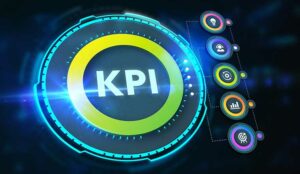If you’re running a contact centre, it’s essential to keep an eye on how well it’s doing. Contact centre metrics & key performance indicators (KPIs) are like report cards for your contact centre.
They help you see how your agents are doing, check the quality of customer calls, and assess user satisfaction.
Understanding KPIs helps you figure out which ones matter most for your centre, and how to make things even better.
In this article, Ruthie Carey at Five9 will walk you through 12 important contact centre KPIs, explain why they’re important, and help you see how to use them to make your contact centre work even better.
What Are KPIs in the Contact Centre?
Contact centres manage a multitude of customer queries from various channels daily, making it crucial to uphold consistent high-quality service for all customers.
A contact centre key performance indicator (KPI) serves as a quantifiable metric employed to gauge the effectiveness and efficiency of contact centre operations.
These KPIs enable you to systematically monitor and assess diverse facets of your customer service and support endeavors.
Common contact centre KPIs encompass metrics such as Average Handle Time (AHT), First Call Resolution (FCR), and Customer Satisfaction (CSAT) scores, which serve as indicators of customer contentment.
By actively overseeing and optimizing these KPIs, you can elevate customer service standards, reduce operational costs, and foster holistic enhancements in your contact centre operations.
Twelve Contact Centre KPIs to Track for Success
Tracking the right key performance indicators (KPIs) in your contact centre is crucial for achieving success and ensuring exceptional customer service.
Here are twelve essential contact centre KPIs you can monitor:
1. First Call Resolution (FCR)
First Call Resolution (FCR), also known as first contact resolution, holds an important position within customer relationship management.
It serves as an indicator of a contact centre’s capability to effectively resolve customer inquiries during the initial contact, eliminating the necessity for subsequent follow-ups or callbacks.
With FCR, you can measure the percentage of customer interactions that find resolution in the first engagement, reflecting how well your agents address issues and reduce the need for follow-up interactions, thus enhancing customer satisfaction.
Importantly, FCR is not confined solely to telephone calls; it also extends to communication channels such as chats and emails.
However, assessing FCR can present challenges, primarily because certain concerns may necessitate actions that extend beyond an agent’s scope.
2. Average Handling Time (AHT)
Average Handle Time (AHT) assesses the average time of customer interactions, including hold and after-call work time.
A lower AHT typically signifies higher agent productivity and enhanced customer satisfaction. However, the pursuit of lower AHT may induce agents to hasten calls, potentially undermining quality.
Thus, it is crucial to strike a balance between speed and quality to safeguard the customer experience. The prudent application of AHT ensures the harmonious coexistence of efficient operations and effective customer service, prioritizing both timely issue resolution and service excellence.
Using AHT judiciously ensures the harmonious coexistence of efficient operations and effective customer service.
3. Service Level
Service Level involves tracking the percentage of incoming calls answered within a predefined timeframe, often expressed as a percentage and time interval (e.g., 80% of calls answered within 20 seconds).
This metric helps in ensuring that customers receive prompt and efficient service. A high service level indicates that the contact centre has the capacity to handle customer inquiries swiftly, minimizing wait times and frustration.
However, maintaining a high service level necessitates robust staffing and call routing strategies to effectively manage call volume fluctuations, ensuring consistent and timely customer support.
4. Abandonment Rate
Abandonment Rate gauges the percentage of customers who disconnect before connecting with a live agent.
High abandonment rates often result in customer frustration, as extended wait times can convey poor service. Such abandonments can arise from technical glitches, understaffing, or prolonged wait times.
Reducing abandonment rates involves strategic measures like optimising call routing, adjusting staffing for peak periods, and introducing self-service options for routine inquiries.
By doing so, contact centres can enhance customer satisfaction and ensure that callers receive timely assistance, ultimately fostering a positive perception of their service.
5. Customer Satisfaction (CSAT)
The Customer Satisfaction Score (CSAT) serves as an indicator of the degree to which customers find the contact centre’s service satisfactory.
Typically gathered through post-interaction surveys, customers rate their satisfaction levels, often on a scale.
CSAT is instrumental in pinpointing precise areas where customers may not be fully content, enabling organizations to enact specific enhancements, thereby enhancing overall service quality.
Vigilant monitoring of CSAT scores and proactive response to feedback empowers companies to cultivate heightened customer satisfaction, foster loyalty, and build trust among their clientele.
6. Net Promoter Score (NPS)
Net Promoter Score (NPS) gauges customer loyalty and willingness to recommend a contact centre’s services. NPS surveys ask customers if they’d recommend the service on a scale of 0 to 10.
Responses categorize customers as Promoters (9-10), Passives (7-8), or Detractors (0-6). Calculating NPS as the percentage of Promoters minus Detractors provides insights into overall satisfaction and referral potential.
Consistently tracking NPS trends enables the assessment of the effectiveness of customer experience initiatives and informs strategic enhancements to fortify customer loyalty and advocacy.
7. Occupancy Rate
The Agent Occupancy Rate represents the proportion of agents’ time devoted to active calls and post-call tasks in relation to their total logged-in time.
While a high Occupancy Rate indicates resource efficiency, it necessitates careful management to avoid overburdening agents, which can result in fatigue, burnout, and reduced service quality.
Effectively handling this metric entails matching staffing levels with demand, deploying efficient call routing and workflow automation, and ensuring agents have adequate break and training intervals.
This approach promotes a balanced operational framework, optimizing performance while preserving agent well-being, thus contributing to a seamless and high-quality customer service experience.
8. Agent Turnover Rate
The Agent Turnover Rate indicates the percentage of contact centre staff leaving the services within a designated timeframe.
Vigilant tracking of this metric holds significance because it offers valuable insights into workforce stability and potential retention difficulties.
Higher Agent Turnover Rates can trigger adverse consequences, such as increased expenses for recruitment and training, reduced team morale, and a decline in customer service quality due to the loss of seasoned agents.
Ensuring the presence of a dependable and proficient workforce is imperative for contact centres to consistently deliver top-notch service quality.
9. Adherence to Schedule
Adherence to Schedule checks if agents follow their assigned work schedules in a contact centre. It allows centres to plan activities without interrupting service and cultivates a productive, accountable work environment.
Effective management includes setting clear expectations, utilizing schedule tracking tools and technology, and implementing supportive policies that balance adherence with reasonable flexibility.
By doing so, contact centres can maintain consistent service levels, enhance customer satisfaction, and optimize resource utilization, ensuring a well-functioning and efficient operation.
10. Call Quality and Monitoring Scores
This KPI involves assessing the quality of customer interactions, examining agent professionalism, adherence to scripts, and overall customer satisfaction.
Call Quality is determined through systematic monitoring of recorded calls or live interactions, while Monitoring Scores provide quantifiable insights into agent performance.
High scores recognize excellence, while lower scores prompt coaching and training. Monitoring ensures consistency, compliance with standards, and enhances customer satisfaction.
It also contributes to continuous improvement through training, fostering a culture of excellence in the contact centre.
11. Average Wait Time
Average Wait Time measures the amount of time customers spend waiting in a queue before their call is answered by an agent or their request is addressed.
Long wait times can lead to customer frustration and dissatisfaction, impacting overall service quality. Therefore, contact centres aim to minimize average wait times to enhance customer satisfaction and maintain efficient operations.
Efforts to reduce wait times may include optimizing staffing levels, implementing effective call routing strategies, and offering self-service options to address common inquiries without the need for live agent assistance.
12. Cost per Contact
Cost per Contact is a metric that quantifies the average expenses incurred when a company engages with a customer across various channels, including phone, email, chat, and social media.
This calculation allows businesses to evaluate the efficiency of their customer service approaches and pinpoint areas for improvement.
Comparing the cost per contact to contact centre industry standards and internal targets provides valuable context to other contact centre metrics.
Reducing the cost per contact while sustaining or enhancing service quality is a primary objective for contact centres, as it enhances operational efficiency and bolsters financial performance.
Choosing an Efficient Tool in Contact Centre KPI Tracking
Efficient tracking tools are the backbone of managing and optimizing contact centre KPIs. These tools provide the best way to gain real-time insights into contact centre performance, customer satisfaction, and service strategies.
Decision-makers can use this data to make informed choices and drive better results. Additionally, these tools allow for proactive KPI monitoring, enabling swift responses to emerging trends or issues.
They streamline reporting, promoting accountability and a culture of improvement. Integration of predictive analytics and AI enhances KPI tracking, helping organizations stay ahead of customer needs.
Remember to select the right tracking tools if you are aiming to improve performance and achieve long-term success.
This blog post has been re-published by kind permission of Five9 – View the Original Article
For more information about Five9 - visit the Five9 Website
Call Centre Helper is not responsible for the content of these guest blog posts. The opinions expressed in this article are those of the author, and do not necessarily reflect those of Call Centre Helper.
Author: Five9
Published On: 24th Oct 2023 - Last modified: 9th Dec 2024
Read more about - Guest Blogs, Five9






 Five9 empowers organizations to create hyper-personalized and effortless AI-driven customer experiences that deliver better business outcomes. Powered by Five9 Genius AI and our people, the Five9 Intelligent CX Platform is trusted by 3,000+ customers and 1,400+ partners globally. The New CX starts here and it's at the heart of every winning experience.
Five9 empowers organizations to create hyper-personalized and effortless AI-driven customer experiences that deliver better business outcomes. Powered by Five9 Genius AI and our people, the Five9 Intelligent CX Platform is trusted by 3,000+ customers and 1,400+ partners globally. The New CX starts here and it's at the heart of every winning experience. 









